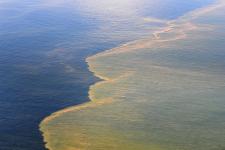
Characteristics
Oil spills are defined as the release of fossil fuel into the environment, regardless of its form and amount. Frequency and severity of human-caused oil spills have increased, especially since the establishment of offshore oil drillings and the transport of oil via ships and pipelines. Even though higher safety standards were introduced, the overall amount of oil entering the oceans has increased. In many cases natural hazards (e.g. earthquakes) cause damages on oil-carrying structures, resulting in a leak. Sometimes however, ships deliberately discharge fossil fuels illegally.
Impacts
Oil spills can impact aquatic as well as terrestrial ecosystems. The degree of environmental, social and economic impact is heavily depending on the type of environment the oil was released to and its composition, quantity and quality. Primary environmental effects include, but are not limited to, the destruction of ecosystems, comprising loss of animal and human habitat and damages to water based industries like local fishery. These impacts are most often non-permanent. However, cleaning efforts are generally high in cost and are can hardly be completed due to the spreading of oil in water. Thick oil slicks from a fresh spill diffuse rapidly, making clean-up operations extremely difficult. For this reason it is necessary to gather information on the oil’s thickness and its distribution as quickly as possible (SEOS).
Emergency Action
Before retrieving spilled oil, information on its location, extent and movement is of crucial importance. Space-based information can be employed to map and monitor oil slicks and even to estimate its volume. To minimize the impact, oil spills need to be contained as quickly as possible. For oil on water surfaces this can be achieved by using floating barriers (booms), which allow for controlling its spread and hence prevent from polluting shorelines and other resources. Once oil is contained within barriers, recovery or removal efforts can begin. Therefore, different types of skimmers and sorbents are used. Skimmers attract oil through suction or oleophilic material. Sorbents are usually fabrics that soak up liquid oil. The right choice of recovery technique depends on environmental conditions such as water currents and wind. Besides mechanical techniques, oil slicks can be dispersed with the help of chemical and biological agents. In some cases, even in-situ burning of oil spills can be an option. If oil somehow reached the shore, other cleanup methods are required. Physical methods, such as wiping, pressure washing or raking are time-consuming and require certain equipment as well as manpower. Natural processes like weathering, evaporation or biodegradation support the cleanup process. Finally, waste material needs to be disposed of in a suitable way. Oil can be recovered if it is possible to separate it from all other substances. Otherwise it can either be burned or placed in landfills.
Mitigation
According to IPIECA’s (International Petroleum Industry Environmental Conservation Association) guidelines on implementing spill impact mitigation (SIMA) there are four stages of a mitigation process.
- Compilation and evaluation of data
Explore relevant oil spill scenarios through modelling and identify resources at risk.
- Prediction of outcomes and impacts
Examine the ‘no intervention’ scenario and analyze effectiveness of potential mitigation strategies.
- Balance trade-offs
Compare benefits and drawbacks for each feasible response option.
- Selection of response strategy
Form strategies for each scenario by selecting techniques, that minimize ecological, socio-economic and cultural impacts and promote rapid recovery.
Further Information
ITOPF: Environmental Effects of Oil Spills (click here)
EPA: Understanding Oil Spills and Oil Spill Response (click here)
IPIECA: Guidelines on implementing spill impact mitigation assessment (SIMA) (click here)
Western Australia Department of Transport: Oil spill contingency plans (click here)
